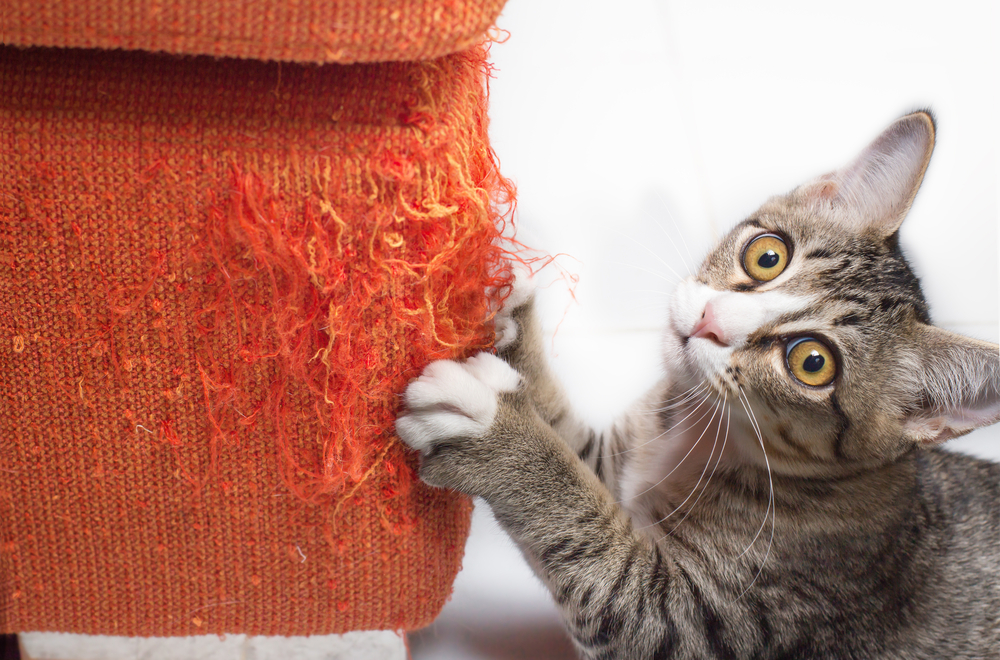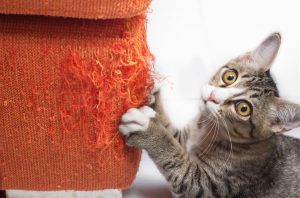As a Cat Owner, you’ve undoubtedly dealt with the frustration of your cat scratching your furniture or the furniture of their doting Pet Sitter’s home. Indeed, we have an entire article devoted to convincing your kitty to keep their claws off the couch.
But, even as you’re working through the behaviour of cat scratching, it’s also a good idea to learn about why cats like to scratch in the first place! Is it because they’re bored, or are they dropping some not-so-subtle hints that they do not approve of your styling choices?
We’ve got the answers you’ve been waiting to get your claws on!
The physical reasons why cats like to scratch
If you’ve been sitting at your desk all day, you know how nice a good stretch can feel every once in a while. If you’re really motivated, maybe you throw in a few push-ups or jumping jacks to get the blood flowing.
As it turns out, your cat has the same thing in mind when they sharpen their claws. Scratching, or stropping as the pros call it, engages the muscles of the paws, forearms, shoulders and back to give your cat a nice mini workout and stretch session. Not only does this feel good to your feline friend, but it keeps them physically fit for hunting.
Scratching is also an important part of claw care. Cats choose their surfaces strategically, seeking out materials that strip the outer layer of the claw to expose the sharp new layer underneath. So, no, your kitty isn’t making a statement about your furniture choices! The reality is, materials like wood, carpeting and sturdy fabrics are the most appealing to your cat. And, bulky furniture items, like couches, also provide stability that allows your cat to really flex those muscles!
The behavioural reasons why cats like to scratch
Scratching isn’t all about the physical benefits. There are a few behavioural reasons why cats sharpen their claws, too!
For one thing, cats have scent glands on their paw pads which allow them to make their mark every time they scratch. Even though you may not be able to read the message, scent marking is a way for your cat to communicate how they’re feeling and create a sense of hominess and togetherness. You might notice that, much to your horror, your cat chooses to scratch the furniture items that are front and centre in your home! But that’s likely because they feel most comfortable in the area where their beloved humans spend time. In essence, scent marking through scratching is comforting and satisfying to cats.
Keep in mind, of course, the scent marking can also be the result of anxiety. If your cat is feeling that their territory is being threatened, they may resort to scratching, rubbing, and even urinating in the areas they want to protect. If you suspect this is the reason for your cat’s scratching, you’ll want to ensure that they feel safe and secure in their environment.
How you can redirect your cat’s natural instinct
As you can see, there are many explanations for why cats like to scratch, all of which are instinctual. So, it’s not reasonable to expect your cat to stop scratching entirely. But, you can make some straightforward changes that will save your furniture:
- Offer designated scratching areas (with incentives). The first thing to put on your to-do list is make sure that your cat has places where they are allowed and encouraged to scratch, even if your cat spends most of their time outside. This could mean a sturdy cat tree, a firewood log, or any scratching post design that your cat enjoys. Cats have their own scratching preferences, so don’t be offended if your cat doesn’t love the model you brought home. Try out different kinds of scratching posts until you find one that your cat responds to. You’ll want to place these scratchers in the area, or even directly in front of, where your cat likes to scratch.
- Resist the urge to punish your cat for scratching. Sure, your cat may stop scratching the moment that you clap your hands or yell at them to stop. But the reality is, instead of fixing the behaviour, you might find that your cat scratches when you’re not around. Instead, when your cat begins to sharpen their claws on your couch, redirect them to the designated scratching post with treats or play. Sprinkling the scratching post with catnip is a brilliant way to spark engagement! When the scratching session is over, consider offering another treat so that your cat builds positive associations with their scratching post. For more cat training tips, take a look at our article, Can Cats Learn to Change Their Behaviour
- Ensure that your cat is mentally stimulated. A cat that is engaged in enriching activities may be less likely to spend their time scratching the furniture. Mentally stimulating experiences can include playtime, outdoor walks on a leash, kitty training, and of course, cuddles from their favourite Owner. For social cats who don’t like to be left alone, you might also call in the help of a dedicated Cat Sitter to provide your cat with mental enrichment while you’re away
- Consider desexing your cat. A 2013 study found that intact male and female cats were more likely to engage in scratching behaviour. Desexing your cat likely won’t eliminate the habit altogether, but you may see a decrease in how often they take their claws to your furniture
- Address territorial anxiety. If your cat is scratching as a symptom of fear or anxiety, you likely won’t be able to solve the problem with only the steps we’ve covered here. You’ll want to work on the root cause of your cat’s anxiety, perhaps with the help of a veterinary behaviourist, in order to phase out the territorial marking
There are many reasons why cats like to scratch, but your furniture doesn’t have to pay the price!
While it can sometimes feel like your cat has a personal vendetta against your home decor, the reality is, they’re acting purely on instinct. Whether your cat is scratching to hone their hunting skills, mark their territory, or enjoy a stress-relieving activity, you can be sure that your cat isn’t doing it to upset you.
Once you understand the instinctual roots of why cats like to scratch, it’s much easier to redirect those claws away from your furniture. As a Cat Owner, you know that changing your cat’s ways can take time, but eventually, you’ll find a com-paw-mise that works for everyone!


